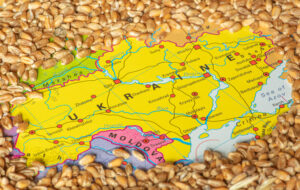
Agrarians of all regions have harvested early grain and leguminous crops on the area of 1495 thousand hectares and threshed 5 million 882 thousand tons of grain at a yield of 39.4 c/ha, the press service of the Ministry of Agrarian Policy and Food reported.
According to the report, the leaders in terms of threshing are the agrarians of Odessa and Mykolayiv regions, who threshed 1297 thousand tons and 344.8 thousand tons of grain respectively.
In total, Ukraine has harvested barley on 577.2 thousand hectares, which is 40% of the planned, from which 2.253 million tons have been threshed at a yield of 39.0 c/ha.
Wheat was harvested from 831 thousand hectares (18%). At a yield of 41.2 c/ha it was threshed 3420.2 thousand tons.
Peas were harvested from 85 thousand hectares (59%). At a yield of 24.6 c/ha it was threshed 208.9 thousand tons. Agrarians of Ternopil and Vinnitsa regions have completed pea harvesting.
In addition, agrarians of 12 regions have started harvesting winter rape: 1390.1 thousand tons of seeds with a yield of 24.7 c/ha on the area of 563.5 thousand hectares (41%).
As reported, winter wheat sowing this season amounted to 4166 thousand hectares (-834 thousand hectares to the previous season), winter barley – 536 thousand hectares (-255 thousand hectares), rape – 1374 thousand hectares (+110 thousand hectares).

The logistics company Soul Marine LLC (Kyiv) will build a 20,000-tonne grain terminal in the port of Izmail (Odesa region) by the end of September, said Ivan Nyakyi, the company’s commercial director, who previously headed Crunchip and Danube Logistics Group, in an interview with Ports of Ukraine.
“At the first stage, we will have 20 thousand tons of one-time storage – four warehouses of 5 thousand tons each. We will have our own laboratory, scales, and everything we need to handle cargo,” he said.
According to Mr. Nikanyi, the necessary equipment has already been purchased.
“Unfortunately, we cannot build our own berth for a simple reason – there is no space. Therefore, we will work through other port operators, which will allow us to load vessels at different berths in Izmail,” he said, adding that preparatory work for the terminal construction has already been completed.
The Commercial Director also informed about the signed contract with the general contractor and the advance payment.
“The other day, the equipment arrived. The first stage of 10 thousand tons will be ready at the end of August, the second – in mid-September,” added Mr. Nikakyi.
It is noted that the company will employ about 10-12 administrative staff and about 30 people at the terminal in Izmail.
Mr. Nyakyi added that Soul Marine also plans to create its own platform for receiving and unloading railroad cars.
“The ability to accept not only vehicles but also railcars will be a great advantage. This is an expensive project, but it is very necessary. We are working on it now,” said the commercial director.
In addition, according to him, in October, Soul Marine plans to reach 60 thousand tons of transshipment through its warehouses, and by the end of the year – 100 thousand tons of transshipment per month. Separately, the company plans to ship 10 thousand tons of its cargo as a trader.
Mr. Nikanyi clarified that the project is being implemented at the expense of an investor who “provides financing and does not interfere with the company’s operations.” He did not name the investor, saying only that it was not related to the transportation or agricultural sectors.
According to the commercial director, Soul Marine’s team includes a technical director who built elevators on the Dnipro, and a corporate director in charge of investments and GR, and a potential terminal manager, forwarder, and agent have been selected.
According to Opendatabot, Soul Marine was registered on June 16, 2023, with a registered capital of UAH 0.5 million. The main activities are non-specialized wholesale trade, auxiliary water transport services, rental of transport and equipment, cultivation of cereals (except rice), legumes and oilseeds.
The company’s ultimate beneficial owner and founder is Mykhailo Kuranda.

The United States will support Ukraine’s grain exports to markets that desperately need them, White House press secretary Karine Jean-Pierre said during a briefing.
“We are going to continue to support Ukraine’s efforts to get Ukrainian grain to markets that desperately need it,” she said.
The spokeswoman also noted the provision of U.S. financial support and supplies for Ukrainian farmers, such as seeds and fertilizer, as well as assistance with crop storage and processing.
In addition, Jean-Pierre recalled that the U.S. government is providing Ukraine with $250 million in financial assistance to support the agricultural sector.
“The United States will allocate another $250 million to the AGRI Ukraine initiative to help Ukrainian farmers produce, store and export agricultural products and grain to global markets,” she emphasized.

Agrarians of 22 regions have harvested early grain and leguminous crops on the area of 643.8 thousand hectares and threshed 2 million 157 thousand tons of grain at a yield of 33.5 c/ha, the press service of the Ministry of Agrarian Policy and Food reported.
According to the report, the leaders in terms of threshing are the agrarians of Odessa and Mykolayiv regions, who threshed 746 thousand tons and 213 thousand tons of grain respectively.
In total, Ukraine has harvested barley on 352.4 thousand hectares (24.6%), which is 16% of the planned, from which threshed 1.3 million tons at a yield of 37.2 c/ha.
Wheat was harvested from 211.8 thousand hectares (4.7%). At a yield of 36.8 c/ha it was harvested 778.7 thousand tons.
Peas were harvested from 45 thousand hectares (31.3%). At a yield of 20.8 c/ha it was threshed 93.7 thousand tons.
Also, agrarians of 12 regions have started harvesting winter rape: 329.5 thousand tons of seeds have been harvested at a yield of 20.8 c/ha on the area of 158 thousand hectares (11.5%).
As reported, winter wheat sowing this season amounted to 4166 thousand hectares (-834 thousand hectares to the previous season), winter barley – 536 thousand hectares (-255 thousand hectares), rape – 1374 thousand hectares (+110 thousand hectares).

Nibulon JV LLC (Mykolaiv), one of the largest operators in the Ukrainian grain market, and Scania Ukraine LLC have signed an agreement to purchase 30 Scania R450 trucks, the grain trader’s press service reports.
“The renewal of the fleet is an integral part of ensuring stable exports of Nibulon. In this case, we are talking about increasing the logistics potential for the transportation of grain by land,” the company wrote on Facebook on Monday.
The grain trader noted that due to the reorientation of export chains during the war and the almost complete loss of river navigation, Nibulon’s logistics business is forced to use combined routes, including grain transportation by truck.
“Nibulon has promised to minimize the load on the roads and minimize its environmental impact. Therefore, the grain is transported by trucks on a short arm to elevators with existing rail shipment capacities.
“Nibulon and Scania Ukraine have been cooperating since 2012. In 2022, Scania Ukraine supplied the grain trader with 15 Scania G400 Euro 5 tractors under the Scania SilverLine program, which includes the purchase of equipment on lease, a service contract, driver training, and a fleet monitoring system. The financing was provided by Scania Credit Ukraine, a member of the Scania Group.
The distribution company Scania Ukraine has been operating in the Ukrainian market since 1998 (before that, it had a representative office since 1993). It has nine service centers (including two of its own in Kyiv and Lviv region).
SCANIA is part of Volkswagen Truck & Bus GmbH and is one of the world’s leading manufacturers of trucks and buses over 16 tons. The company employs 46 thousand people and sells its products in more than 100 countries.
Nibulon JV LLC was established in 1991. It is one of the largest operators in the country’s grain market. It has elevator facilities with a total capacity of about 2 million tons, as well as its own transshipment terminal in Mykolaiv with a capacity of 5 million tons.

Global cereal production in 2023 could reach a record 2.819 billion tonnes, up 1.1 percent from 2022, according to a June FAO (United Nations Food and Agriculture Organization) survey.
Last month’s forecast was raised by 5.9 million tons. “The adjustment is almost entirely due to an improvement in the global wheat crop outlook. At the same time, despite the fact that the forecast of its harvest was raised by 0.9%, to 783.3 million tons, it is still 18.4 million tons below the record level of 2022,” – said in the review.
In particular, harvest estimates in the EU, Canada, Kazakhstan and Turkey were raised. “Expected production gains in these countries more than offset a significant reduction in the production forecast in Australia, where unusually dry weather conditions have led to lower crop views,” the review said.
The forage grain harvest forecast was “slightly lowered” to 1.512 billion tons. But that’s still 2.9% higher than 2022.
“The decrease is due to a downward revision in corn harvest forecasts in East Africa. That said, the improvement in the global barley production forecast is largely due to an adjustment in official estimates for Turkey, where the crop is expected to be higher than originally projected. However, it did not fully compensate for the drop in corn production,” the survey said.
The rice production forecast is “slightly adjusted upward” to 523.7 million tons due to improved crop views in Bangladesh and other countries along and south of the equator. Last year’s revised figures put the crop at 517.6 million tons.